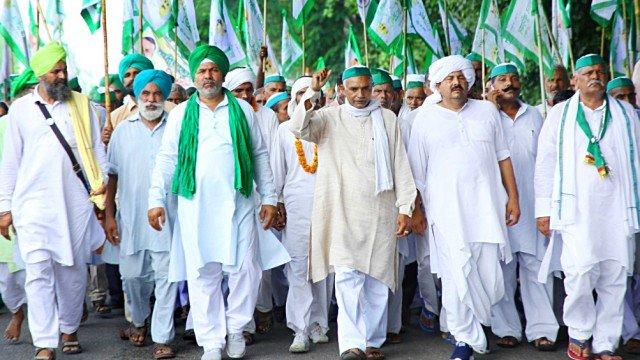Jan Andolan- India’s Landless March Towards Delhi on Gandhi Jayanti

Image Courtesy: National Herald
On the occasion of Gandhi Jayanti, 25,000 landless and homeless poor from across the country adopting a non-violent approach, will be reaching Delhi, marching from Gwalior. United under the banner of the Ekta Parishad, the peasants and tenants are demanding a fair distribution of land.
Speaking with NewsClick, Aneesh Thillenkery, National Convenor of the Ekta Parishad said, "India has a population nearing 1.32 billion as of 2018, and according to the census figures of 2011, about 69% of India's population lives in its villages. They largely depend on land and other natural resources for their livelihood and survival. Sadly, a majority of the rural poor lack secure legal rights to their land. We are fighting to change this - to bring about greater awareness and change where it matters the most - at the policy level."
The Jan Andolan 2018 is aimed at highlighting the issue of land rights of the marginalised communities, facing the wrath of India’s worst ever agrarian crisis. In addition to this, many tenants face discrimination and harassment at the hands of big landowners, with many being forced to accept a paltry price for the labour they put into other people’s land.
Demands of the Marching Peasants
The protestors have commenced their march on foot from Gwalior to Delhi in the hope of building pressure on both the center and the state governments to demand a fresh round of negotiations on the issue of the National Land reforms policy. In a report released by the Ekta Parishad in 2012, it was highlighted that land is a prerogative of each state, and in consequence, land reform is a state subject. The protestors are demanding that a dialogue must be initiated with the states on the same to attain some concrete solutions. Another major concern among the landless is the provision of statutory backing to be provided to the agricultural land and homestead land.
The demands include- the provision of agricultural land to the landless poor in backward districts and the provision of homestead land to the homeless people in rural areas (at least 4 acres). At the moment, the financial assistance provided to homeless families for shelter, through the programme called “Indira Awas Yojana” is not sufficient to achieve this goal. The Ministry of Rural Development should propose doubling the budget granted per unit for providing homestead land to homeless families.
State Governments legislating weaker laws?
Highlighting the current state of landholding, Ramesh Sharma, National Convener of the Ekta Parishad, explained, “Land is a state subject, and most laws related to land - including tenancy and revenue - are passed at the state level. However, these laws are being diluted as state governments are legislating weaker versions of the laws.” The Universal Periodic Review, 2017, issued by the United Nations stated that 57.7 million Indians are landless. Approximately 7% of the population holds 47% of the land, while 93% of the population has access to only 53% of the land holdings.
In this light, the protestors are demanding enhanced land access and land rights for the poor, marginalised and deprived landless. The Parishad, working on the ground, stated that there are laws meant to protect the land rights, and accessibility of land to the poor and marginalised communities of India, but they are not implemented properly. Pointing out the lacunae in their implementation, the members of the organisation explained, “In many cases that we have seen, numerous people can’t access or use their land because a case is pending in court. It often takes several years to get the case solved. We demand the constitution of Fast Track Courts and Land Tribunals for a speedy disposal of the cases pending in courts. Another major issue is that in India, public land can be under the control of the Forest Department or the Revenue Department. Large sections of land are claimed by both the departments, and this situation is putting people who are asking for land titles in great difficulty as it is not clear which department’s legislations are applicable to the land.”
Their other demands include the effective implementation of Panchayats (Extension to Scheduled Areas) Act, 1996 (PESA). PESA is an act giving the power of decision on land issues to the Gram Sabhas (village assembly) in tribal areas. The Ministry of Rural Development should ensure the effective implementation of the Forest Rights Act (FRA). The protestors are also ardently advocating for regular surveys and the updating of records, and clarity over common property resources.
More about Jan Andolan
Jan Andolan as a movement has been ongoing for the past three decades. The Janadesh organised in October 2007 saw 25000 marginalised people and their supporters march from Gwalior to Delhi. Jan satyagraha in October 2012 had 1 lakh people participating and culminated with a 10-point agreement with the Central Government in 2012. However, there is still a long way to go in fully addressing the land issues of the 10.14 crore landless and homeless people of India. Past social actions have contributed to changes like the implementation of Forest Rights Act 2006, drafting of the National Right to Homestead Land Bill and drafting of the Land Reform Policy.
*By contributing 100 rupees, one can make a real difference to their struggle. To contribute and show support to their fight for justice visit-
Bit.ly/DonateToTheLandlessMarch
Get the latest reports & analysis with people's perspective on Protests, movements & deep analytical videos, discussions of the current affairs in your Telegram app. Subscribe to NewsClick's Telegram channel & get Real-Time updates on stories, as they get published on our website.























